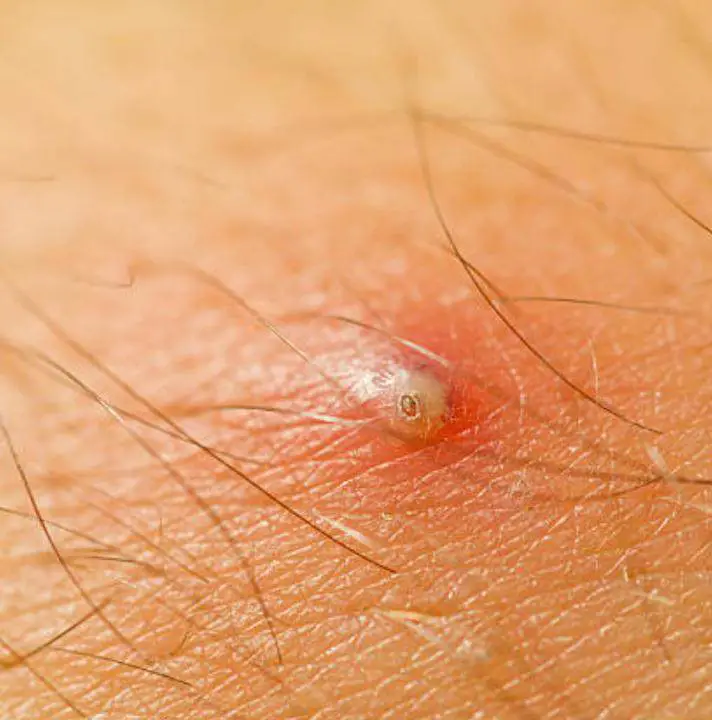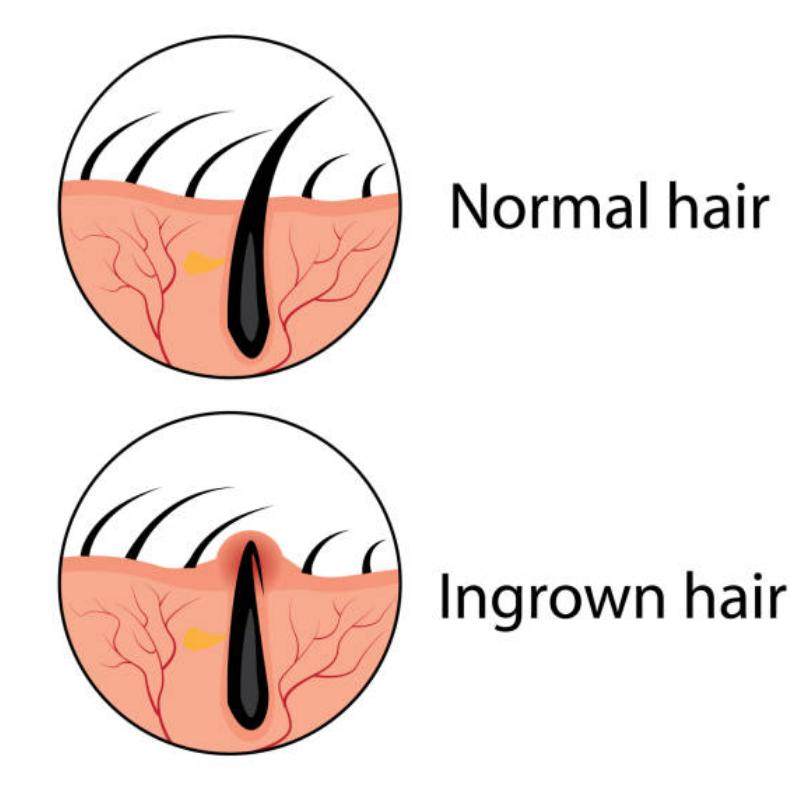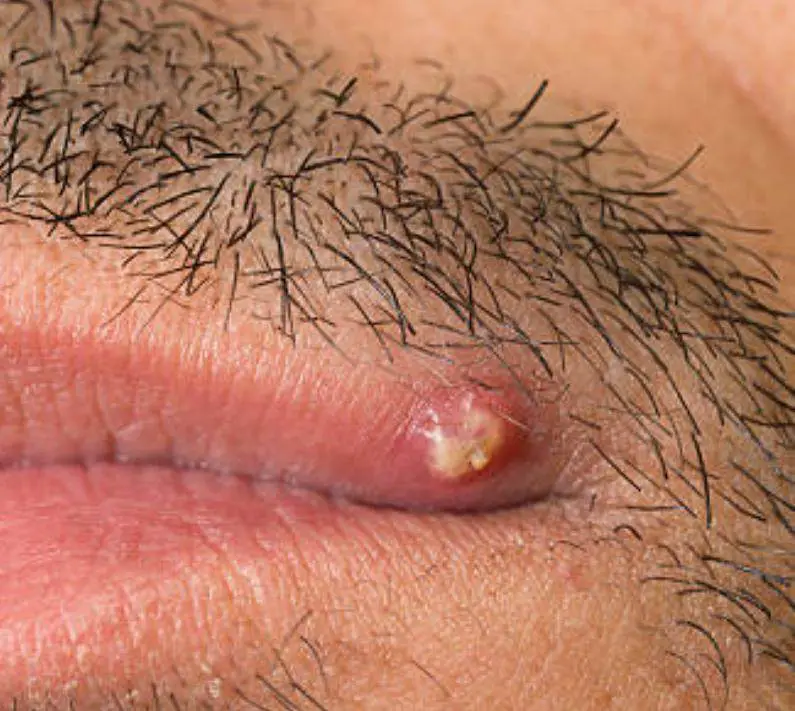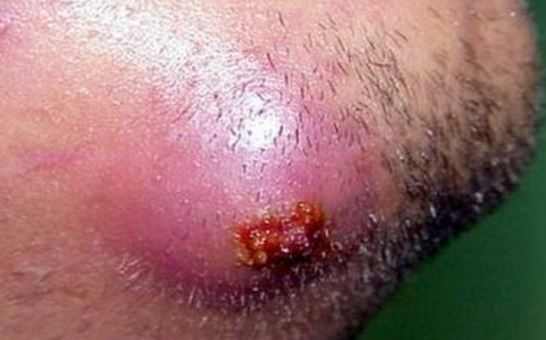An infected ingrown hair causes inflammation in the hair follicle. It may result from clogged or blocked hair follicles and bacteria such as staph. An ingrown hair cyst on the scalp, leg or bikini area may result from the infection. Here are photos of infected ingrown hair follicles, treatment and removal.
Infected ingrown hair photos
What does an ingrown hair look like? Most infections will be evident when a small pus-filled abscess or cyst forms on the ingrown hair. The head of the bump may appear like a pimple with pus. If the infection is severe, the cyst may turn yellow or have green pus. Here are photos of infected ingrown hair follicles.

Ingrown hair infection causes
An infected ingrown hair happens when one of the two things occur. Either the hair curls and then grows back into the skin instead of popping out of the pore. Or also the hair grows sideways into the skin because of the hardened, dead skin cells that is found on the surface, according studies.
As uncontrollable as the situations seem, there are several ways to ensure smooth skin after the hair removal and treatment.
- Naturally coarse or curly hair
Some hair types are very much prone to the infected ingrown hairs, according to the research. Avoid in any way digging into your skin with tweezers, or picking with your fingernails to remove an ingrown hair, as that can cause infection. Instead, doctors suggest applying an alcohol swab and the sterilized tweezers to get rid of hair that is much above the skin’s surface and not infected (visibly red or even blue).
- Wearing clothing that is very tight.
Tight clothing and also the synthetic fabrics, like the nylon leggings, skinny jeans and also polyester underwear may exacerbate the ingrown hairs. Doctors say that it’s best to stick to an easy cotton clothing that is much breathable and won’t even rub against skin.
- Tugging at skin with the razor.
You may not notice but there’s a higher chance that you’re holding the razor very close to the legs, and basically scraping your skin as you shave. It often happens when using a very dull razor that has a worn-down guard, and thus results in irritation that might cause ingrown hairs.
That’s why dermatologists believe that waxing is perfect if done using a good wax that doesn’t break the hair. When shaving, a person should be sure to use a good, thick shave gel that has a sharp razor. Razors should be used for only about 8 times and then tossed. A fresh blade usually prevents razor bumps and ingrown.
- Shaving or waxing in the wrong direction
If the shaving, be sure to lather very well in the direction of the hair growth using a pre-shave creme or even a gel like Completely Bare Moisturizing No-Bump Shave Gel so as to soften stubble. Look for a professional grade at-home waxing kits that are able to grab short, coarse and also the curly hair.
Sugaring is also a perfect alternative to waxing or even a laser hair removal. Its gel is made of sugar, lemon as well as water. As it only stick to the hair and not on the skin, it hurts much less and gets the hair out at the root.
- Not exfoliating regularly after hair removal.
About 48 hours after hair removal is when doctors believe that you can get back to exfoliating. It’s something that would do at the end of the shower as that provides the skin with more time to soak and soften.
Use a mold-resistant wash cloth and an antiseptic body wash that has skin-soothing ingredients such as green tea and the tea tree extracts, working in a gentle and also circular movements.
Symptoms of infection

There are various skin conditions like the scars, bumps and also the sores that are brought about by ingrown hairs. Here is a look at some of the main signs and symptoms of the condition.
1. Inflammation, redness and tender
Inflammation of the infected ingrown hair follicle is called folliculitis. This is a very painful condition that occurs when the shaving is not done correctly. The skin becomes very red and tender indicating an infected ingrown hair.
2. Development of a small, solid hard and much rounded bumps
You can feel some development of a small and rounded bumps that is very hard when you have infected ingrown hair. The sign is often in male after they shave. It can appear on the neck, under the chin also on the cheeks. In women the case is much deferent as it can develop on the pubic parts or any other parts of the body.
3. Itchy and painful bump
Itchy skin few days after even shaving is a symptom and also quick measures on how to do away with ingrown hairs should be taken into consideration.
4. Change of skin color
Skin darkening, the condition called hyperpigmentation is also an indication. For light skin people the symptoms might be observed fast on the neck, cheeks and other part of the body. The infected ingrown hair are always very dark and might be identified by the observation.
5. Development of small, pus filed blister
The inflammation of the skin makes it much tender and the bumps are then filed with the pus due to bacterial attack of the ingrown hair. The bump then swells and burst to release the pus.
How to remove an infected ingrown hair
1.) Get a Pair of Tweezers
Before shaving, or epilating you might take a pair of sterile tweezers and also lift out the infected ingrown hair.
Let the method get rid of them, you just bring them out to the surface of the skin. It’s better to do it like that, to just lift the part of the hair, instead of plucking it from the root. It gets rid of any infection risk.
The extreme situation is when the ingrown hair goes very deep under the skin and you can’t reach it using a tweezer as in that case you can make use a needle. Don’t get scared, it does not hurt, not one bit, and it won’t even leave a scar.
Just take the needle and then poke the bump, it’s very intuitive so there’s very little that needs any learning. Just make sure that the needle is much sterile, you don’t require an infection on top of everything.
In less than one minute, you will obtain the hair out, sometimes a small amount of blood will come out. If the hair is growing inside the skin for a long period of time, it will definitely be a big one. Nevertheless, if you have a very sensitive skin it can be better to stay away from the method. From the doctor’s experience, sensitive skin heals over a longer period of time so that you might get scars if you’re using the tweezer.
2.) Exfoliate
Exfoliation implies doing away with dead cells.
You should always ensure to do it before each and every epilation, waxing or even shaving session and also then daily or even once every three days.
Infected Ingrown hairs may be brought by the existence of a thick layer of dead skin. It’s very logical. The hair can’t break to the surface and even grow normally above the skin due to the dead skin so it curls back under.
3.) Physical Exfoliation
Doctors suggest starting with an exfoliating glove.
It’s very cheap and it gets does away with the dead skin without being very harsh. It’s also people’s favorite.
The method can also be used daily due to the fact that it doesn’t damage the skin, it cleans it very gently. Moisturize after.
Another known physical exfoliation option is through getting exfoliation soaps that have several oils plus oatmeal or salt. The oils assists to keep the skin very hydrated.
These soaps might be applied on a daily basis. Facial or even body scrubs are also doing a perfect job.
For the facial exfoliation, you should also try a facial cleansing brush. It’s very amazing.
4.) DIY Exfoliation
One of the simplest recipes is to put some kosher salt that is in the shower gel and then rub it on the skin. The shower gel then instantly becomes a scrub.
5.) Chemical Exfoliation
When talking about the chemical exfoliation it simply implies using products that have alpha-hydroxy acids or salicylic acid to get rid of the infected ingrown hair.
These should be applied less frequently as they may irritate the skin but they are much efficient exfoliation methods. Each of the product comes with its own set of unique instructions.
6.) Ingrown Hairs Tips When Shaving
For the men, the right method to shave is using the grain. They should ensure to shave in the direction of the hair growth so as to avoid getting ingrown hairs and also razor burns.
Women may shave their legs in the opposite direction without any given worries. Another thing that can lead to the hairs to grow under the skin is shaving using a dull blade.
It’s better to change the razor or even the cartridge frequently. It’s also a good shaving tip that saves a person from the nicks.
Don’t forget on exfoliation. It’s just as vital as it is in the case of waxing as well as epilation.
7.) Epilating Tips To Prevent Ingrown Hairs
There is a belief that the type of epilator that a person uses might influence the number of ingrown hairs it can get.
People are not entirely convinced that there is a relation between the epilator model as well as the number of ingrown hairs that are going to happen.
An example could be that if you get a device that has several tweezers, such as the one with 72 tweezers, the number of passes required is reduced and, being that powerful, it gets rid of all the hairs from the root instead of cutting the short thin ones.
Or getting an epilator using ceramic tweezers that are very strong, hypoallergenic and also completely safe.
Those are a few tips on how to prevent the ingrown hairs but you will still get them, no matter what you do. The idea is to keep everything under good control so as to have as little of them as possible.
All of the above tips are also perfect for fighting of the infections and also the irritation but, in the end, laser hair removal and also the electrolysis are the only hair removal ways that can do away with ingrown hairs for good, only if all of us might afford one or even the other.
Infected ingrown hair treatment

Infected ingrown hair do not normally go away on itself and for that particular reason it requires treatment by the doctor or by use of over the counter prescriptions. The doctor can make use of sterile scalpel or even needle so as to release the bump.
Alternatively the doctor can advocate for the steroids medicine that you can rub on the skin to ease the swelling and even the irritation. Steroids medicine also makes the affected spot of the skin to be healed faster. Antibiotics may be taken orally or even directly be used on the skin so as to treat ingrown hair infection
Home remedies for infected ingrown hairs
1. Sugar remedy to get rid of ingrown hair
Sugar is a great skin scrub that can help get rid of infected ingrown hair. It gently exfoliates the skin, removing dead cells and helping the ingrown hair come out of the skin. Also, it will make the skin to appear silky smooth.
- Mix a cup of the white sugar with a half of a cup of extra-virgin olive oil or jojoba oil.
- Stir in about 15 drops each of the tea tree oil and also lavender essential oil.
- Use a small amount of the homemade scrub on the affected skin area.
- Gently scrub the area in circular motions for about 10 minutes. Then rinse it off using lukewarm water.
- Follow the remedy once or even twice a week as required.
You may store the remaining of the scrub in an airtight container for the future use.
- Baking Soda
Baking soda contains a soothing effect on the infected ingrown hair because of its anti-inflammatory properties. Also, it assists to relieve itching by exfoliating of the skin and also reduces redness brought about by ingrown hairs.
- Mix three tablespoons of baking soda and one cup of water. Dip a clean cotton ball in the solution. Dab it on the affected skin area. Leave it on for about 10 minutes and then wash it off using cold water. Repeat about three times daily as required.
- You can also make a homemade scrub with about one teaspoon each of the baking soda and also ground oatmeal and a tablespoon of water. Mix the ingredients together so as to create a paste. Use it gently on the skin and then leave it on for not more than ten minutes. Then rinse if off using lukewarm water and then gently pat the skin dry. Follow the remedy twice daily as needed.
- Tea Tree Oil remedy for infection
Tea tree oil contains antibacterial, antiseptic as well as the anti-inflammatory properties that assist to heal the infected ingrown hair and also prevent infection.
We highly recommend Essential Oil Labs Tea Tree Oil (Check price on Amazon)
- Add five drops of the tea tree oil to about two tablespoons of the distilled water. Use the diluted tea tree oil on the affected skin area after cleansing of the area using antibacterial soap. Leave it on for about 15 minutes and then rinse the area using lukewarm water. Do the process twice daily as needed.
- Mix three drops of the tea tree oil in one tablespoon of the olive oil. Apply the mixture on the affected area and gently massage it for a few minutes. Leave it on for about 15 minutes and then rinse using lukewarm water. Follow the remedy twice daily as required.
- Aspirin
Aspirin can assist to reduce the redness and the inflammation, the two common symptoms of ingrown hair. The anti-inflammatory property of the aspirin reduces the swelling, fights inflammation and also treats mild infection. Also, the salicylic acid that is available in aspirin scrubs away dead skin so as to loosen the offending hair.
- Soak about three aspirin tablets in a teaspoon of warm water until it forms a paste-like consistency.
- Add a teaspoon of honey to the formed paste.
- Use the paste to the affected skin area.
- Leave it on for about 20 minutes. Wash it off with warm water and then gently pat the skin dry.
- Follow the remedy at least once or even twice a week as needed.
Those people with highly sensitive skin should not follow the remedy.
- Salt for exfoliation
Salt works as a perfect exfoliating agent and at the same time assists to increase circulation, promote the healing of the infected ingrown hair and also reduce the swelling.
- Mix about one and one-half teaspoons of the table salt in a cup of lukewarm water.
- Dip a cotton ball in the mixture and then gently rub it over the affected area of the skin.
- Leave it on for a few minutes and then rinse it off with water.
- Do the process twice daily until the ingrown hair clears up.
Do not use the remedy if the skin gets red or even irritated.
- Black Tea Bags
Black tea bags might also assist to get rid of ingrown hairs. Black tea has tannic acid that reduces redness and inflammation and helps soothe the skin.
- Moisten a black tea bag in warm water. Rub it over the affected area for two to three minutes. Repeat several times daily as required.
- Alternatively, you can steep a black tea bag in the hot water for a few minutes. Remove it from the water and squeeze out the liquid in it into a bowl. Mix in it one teaspoon of coconut water. Soak a clean cotton ball in the mixture and then press it very gently on the irritated skin. Do the process about two times daily for a few days until you observe an improvement.
- Aloe Vera soothes inflammation
Aloe vera is another effective home remedy for the infected ingrown hair or razor bump. The soothing as well as cooling nature of aloe vera provides instant relief from the itchiness and inflammation. Also, the aloe vera can keep the skin much moisturized and then speed up the healing process.
A great choice would be organic cold pressed Aloe Vera gel (Check price on Amazon)
- Extract the gel from the aloe vera leaf.
- Rub the gel formed on the irritated skin. Allow it to dry on its own for about half an hour.
- Rinse it off with lukewarm water.
- Do this two or three times daily for a few days.
- Honey
Honey has antibacterial properties that can prevent the affected spot from becoming much infected. Also, honey moisturizes the skin and also reduces swelling and inflammation.
- Use a layer of honey directly on the irritated skin.
- Let it air dry for about 15 minutes. Then rinse it off with cold water.
- Follow this remedy three or even four times a day for as long as required.
- Apple Cider Vinegar
Apple cider vinegar contains anti-inflammatory properties that assists reduce inflammation and soothe the infected ingrown hair. Plus, it assists to destroy skin of the bacteria and yeast, which in turn reduces the risk of infection.
- Using a cotton ball, apply the apple cider vinegar on the affected area.
- Allow it some time for the skin to absorb it. Then wash the area with lukewarm water.
- Follow the simple procedure twice daily.



Thanks for the very informative post. For my opinion, we can avoid ingrown by using the right tool for hair removal. I personally use an epilator. Really easy to use and gives me the best result I wanted.